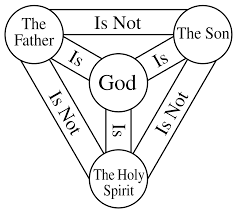Trinity(noun) Old French trinite, from Late Latin trinitatem
- Father, the Son and the Holy Spirit are One God (not three Gods.)
- The Father, the Son and the Holy Spirit are equal in power and glory, and the same in essence.
- The Father functionally is superior to the Son and the Holy Spirit (both Son and the Spirit are obedient to the Father)

A TRINITY DIAGRAM
Like the illustration, the Trinity doctrine is confusing and illogical
This teaching was first made universally official by the Emperor Constantine who saw Greek as a beautiful and romantic language - much as modern Americans view French.. It is said that during council debate on the nature of God, presided by Constantine, - the Emperor heard the word homoousios spoken by one of the debaters and found the word so beautiful he immediately declared it to be a doctrine to be adopted by the church
The confusion over the doctrine no doubt has arisen from the interpretation of the word person. In the modern world, the word person means an individual being. But in ancient Greek, a persona was the mask worn by an actor. In other words, the doctrine is saying God wears three masks, Father, Son and Holy Ghost, but is just one being.
As it stands now the Trinity is a being who exists, simultaneously and eternally, as a mutual indwelling of three personalities the Father, the Son (incarnated as Jesus) and the Holy Spirit.
In the fourth century, Arianism taught that the Father existed prior to the Son who was not, by nature, God but rather a changeable creature who was granted the dignity of becoming "Son of God". About the Father and the Son, the creed used the term homoousios (Greek. of one substance) to define the relationship between the Father and the Son.
The Confession of the First Council of Nicaea, the Nicene Creed, said little about the Holy Spirit. but all attention was focused on the relationship between the Father and the Son, without making any similar statement about the Holy Spirit. In the words of the creed:
Non Trinitarian Christians
By far the three largest nontrinitarian Christian denominations
are The Church of Jesus Christ of Latter-day Saints ("Mormons"),
Jehovah's Witnesses, Christian
Scientists, Unitarian Universalists, and the United Church of
God. There are a number of smaller groups, including the Iglesia
Ni Cristo, Christadelphians, Dawn Bible Students, Living Church
of God, Oneness Pentecostals, the Church of God International
and The Way International.
Non-trinitarian views differ widely on the nature of Jesus, and
the Holy Spirit. Various nontrinitarian philosophies, such as
Adoptionism, Monarchianism, and Subordination-ism existed prior
to the establishment of the Trinity doctrine in AD 325, 381, and
431, at the Councils of Constantinople, and Ephesus. Non-trinitarianism
was later renewed by the Cathars in the 11th through 13th
centuries, in the Unitarian movement
during the Protestant Reformation, in the Age of Enlightenment
of the 18th century, and in some groups arising during the
19th century.